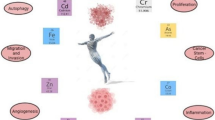Abstract
Objective: The paper describes the results of a polycentric study for the assessment of reference values of urinary chromium (U-Cr) in the Italian population.
Method: A total of 890 subjects (58.3% males and 41.7% females) were selected on the basis of standardized criteria in eight different areas of Italy. Urinary chromium was determined on morning spot samples collected using standardized procedures. The U-Cr was determined independently by three laboratories using an Electrothermic atomization-Atomic Absorption Spectrometry (ETA-AAS) method with a detection limit of 0.05 μg/l, adopting – for the statistical analysis – the median value of the results of the three laboratories. The between-laboratories within-subjects standard deviation was 0.049 μg/l. Due to the high proportion (approx. 28%) of undetectable chromium levels, the geometric mean (GM) and geometric standard deviation (GSD) were estimated using a procedure of linear interpolation. The analysis of the effects of some variables (sex, age, center, residence, smoking and drinking habits) on the U-Cr values was also performed, by multiple regression analysis after logarithmic transformation, using GM and SD.
Results: The reference value of U-Cr was of 0.08 μg/l as an estimated GM, whereas the expected distribution ranged from not detectable (nd) (95% CI = nd–0.06) to 0.24 μg/l (95th percentile; 95% CI = 0.20– 0.31). Among the variables studied, only geographical area and sex significantly influenced the U-Cr levels. In subjects selected in the provinces of Bari and Venice values of U-Cr were significantly lower than those determined in subjects residing in other areas.
Conclusions: From our investigation the reference values for U-Cr were lower than those obtained in previous investigations. In addition it confirms a further reduction in U-Cr levels following the previous decline reported in the 1970s and 1980s. In over 20 years U-Cr values in the general population dropped from values greater than 1 μg/l to values between 0.5 and 0.2 μg/l. The reasons of this progressive decline cannot be attributed in our opinion to a reduced intake of the metal, but mainly to the improvement in analytical instrumentation and methods. A further decrease may be ascribed to a more accurate definition of the reference groups and to a better control of pre-analytical factors. Considering that the reference values for U-Cr are much lower than those determined some decades ago, toxicological studies in order to verify the significance of biological limit values currently suggested for chromium seem to be necessary.
Similar content being viewed by others
Author information
Authors and Affiliations
Additional information
Received: 26 November 1996 / Accepted: 7 February 1997
Rights and permissions
About this article
Cite this article
Apostoli, P., Maranelli, G., Duca, P. et al. Reference values of urinary chromium in Italy. Int Arch Occup Environ Health 70, 173–179 (1997). https://doi.org/10.1007/s004200050203
Issue Date:
DOI: https://doi.org/10.1007/s004200050203




